Additive fixatives Study guides, Class notes & Summaries
Looking for the best study guides, study notes and summaries about Additive fixatives? On this page you'll find 30 study documents about Additive fixatives.
All 30 results
Sort by
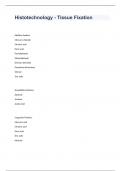
-
Histotechnology - Tissue Fixation fully solved updated to pass
- Exam (elaborations) • 11 pages • 2023
- Available in package deal
-
- $17.99
- + learn more
Histotechnology - Tissue FixationAdditive fixatives Mercuric chloride Chromic acid Picric acid Formaldehyde Glutaraldehyde Osmium tetroxide Potassium dichromate Glyoxal Zinc salts Nonadditive fixatives Alcohols Acetone Acetic Acid Coagulant Fixatives Mercuric acid Chromic acid Picric acid Zinc salts Alcohols Acetone Acetic acid Noncoagulant Fixatives Formaldehyde Glutaraldehyde Osmium Tetroxide Potassium Dichromate Glyoxal Are coagulant fixatives addit...
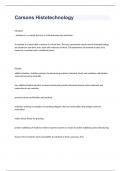
-
Carsons Histotechnology verified to pass 2023/2024 passed
- Exam (elaborations) • 111 pages • 2023
- Available in package deal
-
- $23.99
- + learn more
Carsons Mordant . substance’s or metals that act as a link between dye and tissue A mordant is a metal with a valency of at least two. The two commonest metals used in histotechnology are aluminum and ferric iron, both with valencies of three. The attachment of mordant to dyes is by means of a covalent and a coordinate bond. Fixative additive fixation- stabilizes proteins by denaturing proteins (chemical, heat) and combines with fixative molecule becoming insoluble non additive ...
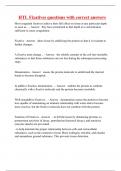
-
HTL Fixatives questions with correct answers
- Exam (elaborations) • 41 pages • 2023
- Available in package deal
-
- $16.99
- + learn more
Most coagulant fixatives achieve their full effect on tissue at any particular depth as soon as... - Answer they have penetrated to that depth at a concentration sufficient to cause coagulation. Fixative - Answer alters tissue by stabilizing the protein so that it is resistant to further changes. A fixative must change... - Answer the soluble contents of the cell into insoluble substances so that those substances are not lost during the subsequent processing steps. Denaturation - ...
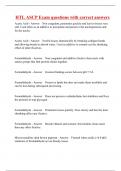
-
HTL ASCP Exam questions with correct answers
- Exam (elaborations) • 17 pages • 2023
- Available in package deal
-
- $14.99
- + learn more
Acetic Acid - Answer Non coagulant, penetrates quickly and leaves tissues very soft. Used often as an additive to precipitate and preserve the nucleoproteins and fix the nuclei. Acetic Acid - Answer Swells tissues dramatically by breaking collagen bonds and allowing bonds to absorb water. Used as additive to counter-act the shrinking effect of other fixatives. Formaldehyde - Answer Non coagulant and additive fixative that reacts with amino groups that link protein chains together....
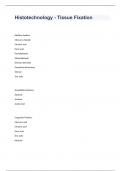
-
Histotechnology - Tissue Fixation 2024 passed
- Exam (elaborations) • 11 pages • 2024
- Available in package deal
-
- $16.99
- + learn more
Histotechnology - Tissue FixationAdditive fixatives Mercuric chloride Chromic acid Picric acid Formaldehyde Glutaraldehyde Osmium tetroxide Potassium dichromate Glyoxal Zinc salts Nonadditive fixatives Alcohols Acetone Acetic Acid Coagulant Fixatives Mercuric acid Chromic acid Picric acid Zinc salts Alcohols Acetone Acetic acid Noncoagulant Fixatives Formaldehyde Glutaraldehyde Osmium Tetroxide Potassium Dichromate Glyoxal Are coagulant fixatives addit...
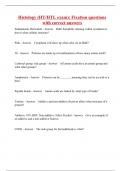
-
Histology (HT/HTL exam): Fixation questions with correct answers
- Exam (elaborations) • 10 pages • 2023
- Available in package deal
-
- $13.99
- + learn more
Endoplasmic Reticulum - Answer H&E basophilic staining within cytoplasm is due to what cellular structure? Pink - Answer Cytoplasm will show up what color on an H&E? 20 - Answer Proteins are made up of combinations of how many amino acids? Carboxyl group, side group - Answer All amino acids have an amino group and what other groups? Amphoteric - Answer Proteins can be _______, meaning they can be an acid or a base. Peptide bonds - Answer Amino acids are linked by...
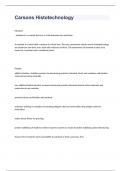
-
Carsons Histotechnology with 100% c0rrect answers 2024
- Exam (elaborations) • 111 pages • 2024
- Available in package deal
-
- $26.49
- + learn more
Carsons Mordant . substance’s or metals that act as a link between dye and tissue A mordant is a metal with a valency of at least two. The two commonest metals used in histotechnology are aluminum and ferric iron, both with valencies of three. The attachment of mordant to dyes is by means of a covalent and a coordinate bond. Fixative additive fixation- stabilizes proteins by denaturing proteins (chemical, heat) and combines with fixative molecule becoming insoluble non additive ...

-
BOC Study Guide Histotechnology 2nd ed.- Fixation (HT) fully solved graded A+ 2023/2024
- Exam (elaborations) • 11 pages • 2023
- Available in package deal
-
- $17.99
- + learn more
BOC Study Guide Histotechnology 2nd ed.- Fixation (HT)An example of an additive fixative is one that contains: - correct answers picric acid Microscopic examination of an H&E stained section fixed in formalin shows marked nuclear bubbling. One most often sees this artifact if the specimen is processed following: - correct answers incomplete fixation Microscopic evalution of H&E stained sections from a surgically removed small bowl specimen shows an absence of much of the epithelium in othe...
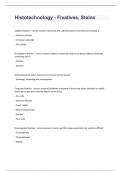
-
Histotechnology - Fixatives, Stains 2024 passed
- Exam (elaborations) • 10 pages • 2024
- Available in package deal
-
- $17.99
- + learn more
Histotechnology - Fixatives, Stains Additive fixatives - correct answers Chemically link, add themselves on to tissue and change it - Mercuric chloride - Chromium tetroxide - Zinc sulfate Nonadoptive fixatives - correct answers Organic compounds that act on tissue without chemically combining with it - Acetone - Alcohols Dissociate bound water molecules from tissue protein groups - Shrinkage, hardening with overexposure Coagulant fixatives - correct answers Establishes a network ...
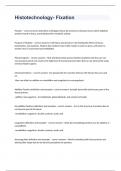
-
Histotechnology- Fixation question & answers graded A+ 2023/2024
- Exam (elaborations) • 6 pages • 2023
- Available in package deal
-
- $12.99
- + learn more
Histotechnology- FixationFixation: - correct answers Alteration of biological tissue by chemical or physical means which stabilizes proteins found in tissue, preventing further metabolic activity. Purpose of Fixation: - correct answers To kill tissue and preserve it by limiting the effects of decay, putrefaction, and autolysis. Fixation also hardens tissue which makes it easier to gross, and easier to section once it is processed and embedded. Physical Agents: - correct answers - Heat and ...



